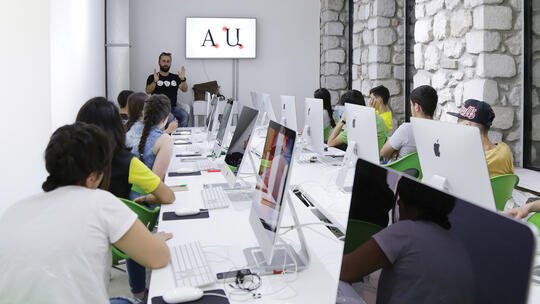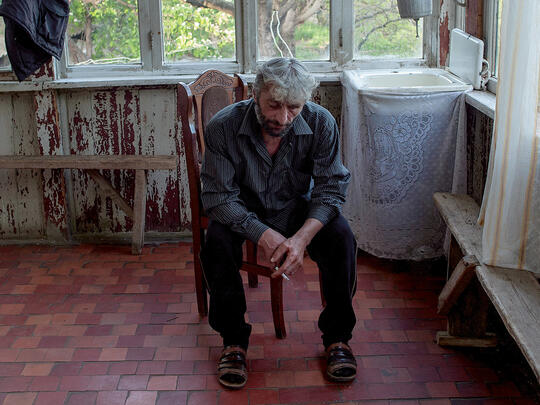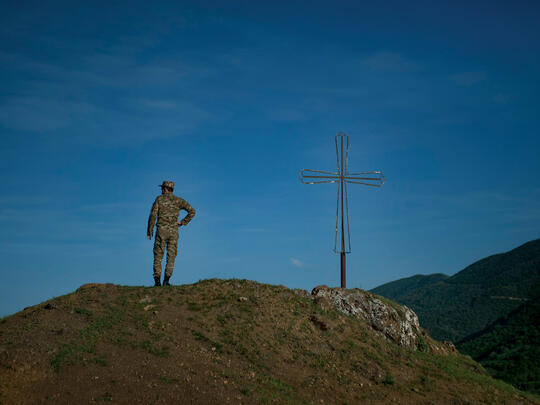When news of the clashes on the border of Nagorno-Karabakh and Azerbaijan in April reached Stepanakert, the entire city tensed. The minds of those who lived through the Nagorno-Karabakh War in the 1990s could not help but fear a return of darker times. Once the hostilities abated four days later, the people of Nagorno-Karabakh could let out a collective sigh of relief, but not without a certain degree of apprehension. The antidote to this apprehension for many of the residents of Nagorno-Karabakh was to return to the rhythms of their everyday lives, including, for students, to nurturing hope for educational achievement—with the help of AGBU.
In Stepanakert, AGBU sponsors two educational programs that have only flourished since the attacks in April: the TUMOxAGBU Stepanakert Center and the American University of Armenia (AUA) Extension Program. A testament to the resilience and commitment to learning in the people of Nagorno-Karabakh, the programs have not only remained intact, but have continued to grow, develop and expand to meet the needs of curious students striving for success in their careers—whether these are careers about to begin or those well underway.
TUMOxAGBU Stepanakert has always been a haven for the youth of Nagorno-Karabakh and, in the aftermath of the clashes, it continued to serve its function with renewed determination: “During the attacks, it was very tense at home, especially because my dad works in the army,” said 14-year-old Samvel Sargsyan. “But at TUMO, everything was different. I went to the center because I felt safe and secure there. It has a very special atmosphere.”
Officially inaugurated in September 2015 as a new hub for learning, creativity and technology in the capital of Nagorno-Karabakh, the center marked the beginning of a partnership between AGBU and the TUMO Center for Creative Technologies, which also collaborated to establish TUMOxAGBU Gyumri in the same year.

The city of Stepanakert and its neighboring regions were abuzz with excitement when the center opened for classes in October 2015 and interest in its animation, filmmaking, computer programming, music, photography and graphic design classes has only grown, fostering a contagious spirit of excitement and optimism. The teenage students—ages twelve to eighteen—who attend the TUMOxAGBU afterschool classes have their sights set on greatness in the world of technology—and nothing, not even political unrest, will stand in their way.
Since April, the TUMOxAGBU Stepanakert Center, which only closed its doors for one day at the height of the attacks, continued to hold its workshops in writing, graphic design, programming and web development as well as introduce special learning labs. “Both before and after April, the mission of TUMOxAGBU Stepanakert has been to give students everything they need to succeedin the future along with maintaining a feeling of stability,” said Korioun Khatchadourian, head of TUMOxAGBU Stepanakert. “The learning labs helped show the students that life has returned to normal and that the path toward the future is clear.”
In May and June, TUMOxAGBU Stepanakert welcomed four accomplished professionals to impart their wisdom to enthusiastic young students.
In May, world-renowned photojournalist Scout Tufankjian made her first visit to the center in Stepanakert to teach a group of sixteen students about the fundamentals of documentary photography and help them develop their skills. For this learning lab, TUMO partnered with the HALO Trust to raise awareness about the organization’s humanitarian work in clearing landmines and explosives from Nagorno-Karabakh. During the lab, the young photographers created photo-stories that featured the landscapes, everyday life and people of their city, focusing on the areas cleared by HALO and allowing the students to see their region through the lens of peace and normalcy. “I want to be a professional photographer and TUMO has made it possible for me to stay in Stepanakert to pursue a career in the field. I discovered photography at TUMO—a place filled with joy and hope and oriented toward the future—and Scout’s course helped me learn even more,” said 16-year-old Nina Shahverdyan.
Later in the month, the students were visited by Sevana Tchakerian, lead musician in the French Armenian band Medz Bazar and founder of the music education organization Tsap-Tsapik. Tchakerian spent two weeks at TUMOxAGBU Stepanakert, teaching a learning lab on singing, rhythm and vocal harmonization. She also devoted time to making her students comfortable with the digital audio software Logic Pro X, enabling them to create compositions on the computer and arrange new renditions of Armenian folk songs. “It’s important for Armenian musicians to own their culture and have a link with their past, but also not feel confined by it and break boundaries to create something new. I want the students to use their history to create something beautiful together,” said Tchakerian.
In June, Sedrak Mkrtchyan, a graphic designer and head of design at the PanArmenian media group, introduced students to the world of infographics along with typefaces, fonts and grids. Over the course of a month, students learned about the foundations and history of infographics along with different methods of expression for composition, color, typography and data. In the same month, Grigor Atanesian, editor at Russian Esquire, also gave a learning lab on digital storytelling for the students at TUMOxAGBU Stepanakert.
During a time of great uncertainty, TUMO inspired hope in the young students, offering them a sense of excitement about the future of Nagorno-Karabakh: “TUMO has made it possible for me to learn the basics of computer programming. I would like to become a programmer—staying local, but reaching the global market,” said 14-year-old Armine Hakopyan.

At the AGBU-sponsored American University of Armenia (AUA) Extension Program in Nagorno-Karabakh, students also persevered in the face of April’s hostilities. The AUA Extension Program—with other branches in Gyumri, Dilijan, Yeghegnadzor and Yerevan—plans, designs and develops courses to meet the needs of public and private sector organizations to help students fulfill their professional goals through continuing education programs for adults, including trainings, workshops and seminars.
“The AUA courses that I had the privilege to attend have given me the determination to succeed and allowed me to diversify in my role. Although, I cannot say that I was able to use all that I learned, however, the skills and knowledge obtained from the course have allowed me to review my approach to certain issues and tailor the knowledge I’ve gained to the needs of my position and workplace. Hence, it has paved the way to new ways of observing and dealing with issues that have proved to be useful in life and at work,” said Armine Aleksanyan, Deputy Foreign Minister of Nagorno-Karabakh.
The AUA Extension Program dates to 2013 when the collaboration between AGBU and AUA began with the goal of reigniting the workforce in Nagorno-Karabakh. Since then, the program has offered more than 130 courses and trained more than 2,100 students. It has also given special attention to equipping future civil servants of Nagorno-Karabakh with the skills needed to achieve excellence in their careers. In particular, the program offers six levels of English language instruction, computer literacy and information technology training as well as leadership, business management and entrepreneurship courses to foster individual, organizational and community growth and transformation.
Since the April attacks, many classes were suspended as students—many of whom are military servicemen—rushed to the frontlines, but AUA’s commitment to the program remains unwavering. “The AGBU-supported AUA Extension Program in Stepanakert is aimed at preparing future leaders in the public sector. The fact that the AUA Extension program in Stepanakert caters to current and aspiring functionaries means that our classes have the potential to mold a cadre of public leaders who are better prepared to face challenges. Our courses in public management are tailored to meet the specific needs of the civil servants in various departments of Nagorno-Karabakh and the National Assembly,” said Arpie Balian, director of the AUA Extension Program.
AUA is a private, independent university in Yerevan, Armenia established through a partnership with the government of Armenia, AGBU and the University of California. As one of the founding organizations of AUA, AGBU has been involved in the university since its establishment in 1991. AGBU has proven to be a champion for AUA through financial assistance in the launch of academic programs and scholarships as well as the establishment of the AGBU Papazian Library. AUA provides a global education in Armenia, offering high-quality, graduate and undergraduate studies, encouraging civic engagement and promoting public service and democratic values.
“The courses organized in Nagorno-Karabakh within the framework of the AUA Extension Program offered a great opportunity for me to learn about the American educational approach. My participation in the program was a unique opportunity to enhance my professional skills in different areas, especially in terms of improving my business communication skills. It is thanks to these AGBU-sponsored courses that now I can communicate with many international organizations, governmental and non-governmental organizations by generally accepted communication standards,” said Artak Grigoryan, project manager at the Tourism Department of the Ministry of Economy.
With the conflict behind them, the students at TUMOxAGBU Stepanakert and the AUA Extension Program feel even stronger in their devotion to education and even more confident in their futures in Nagorno-Karabakh.















